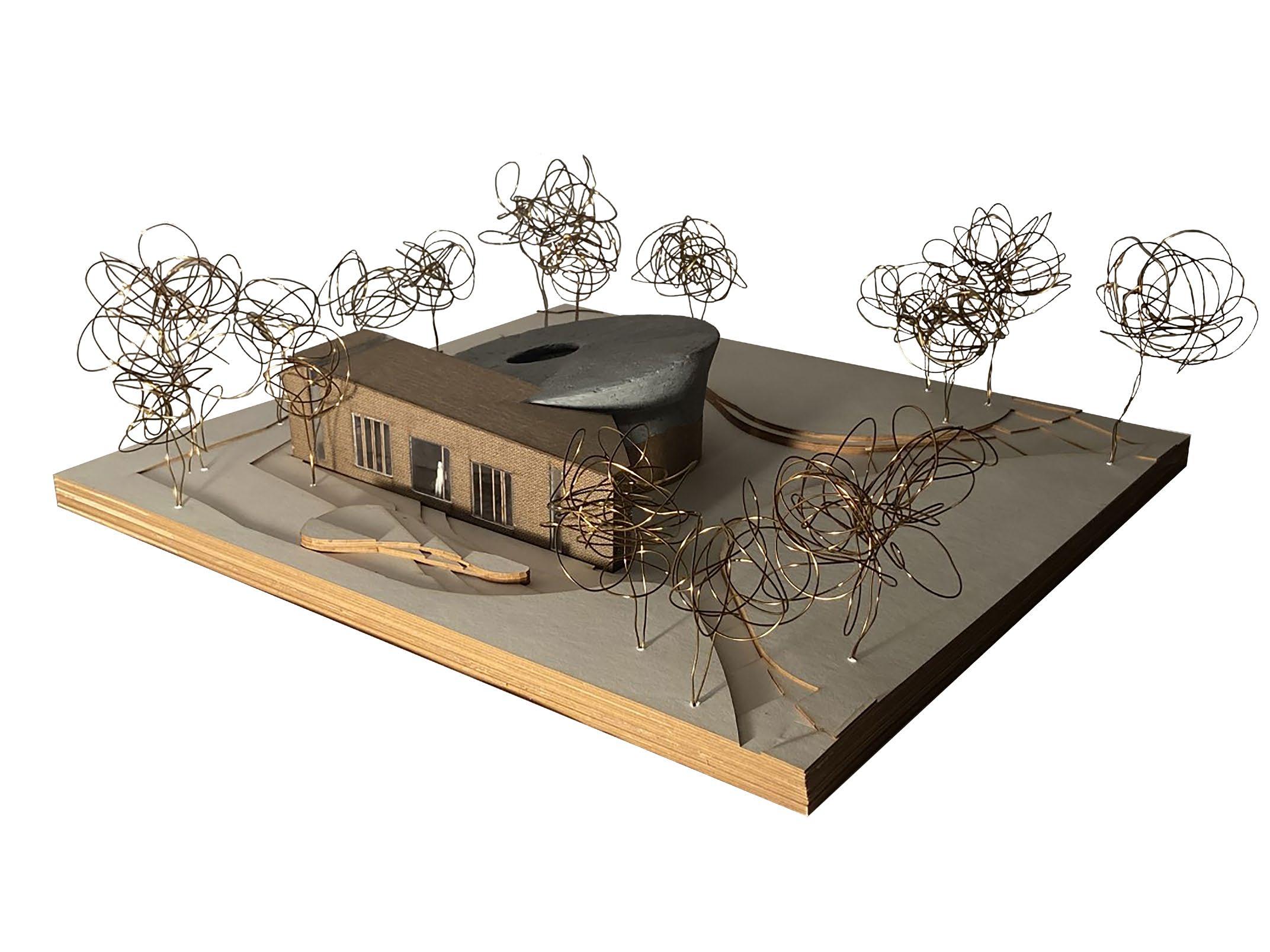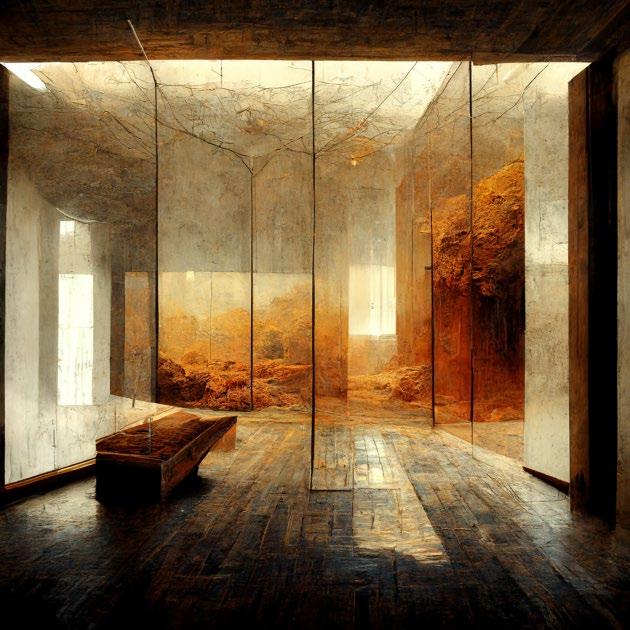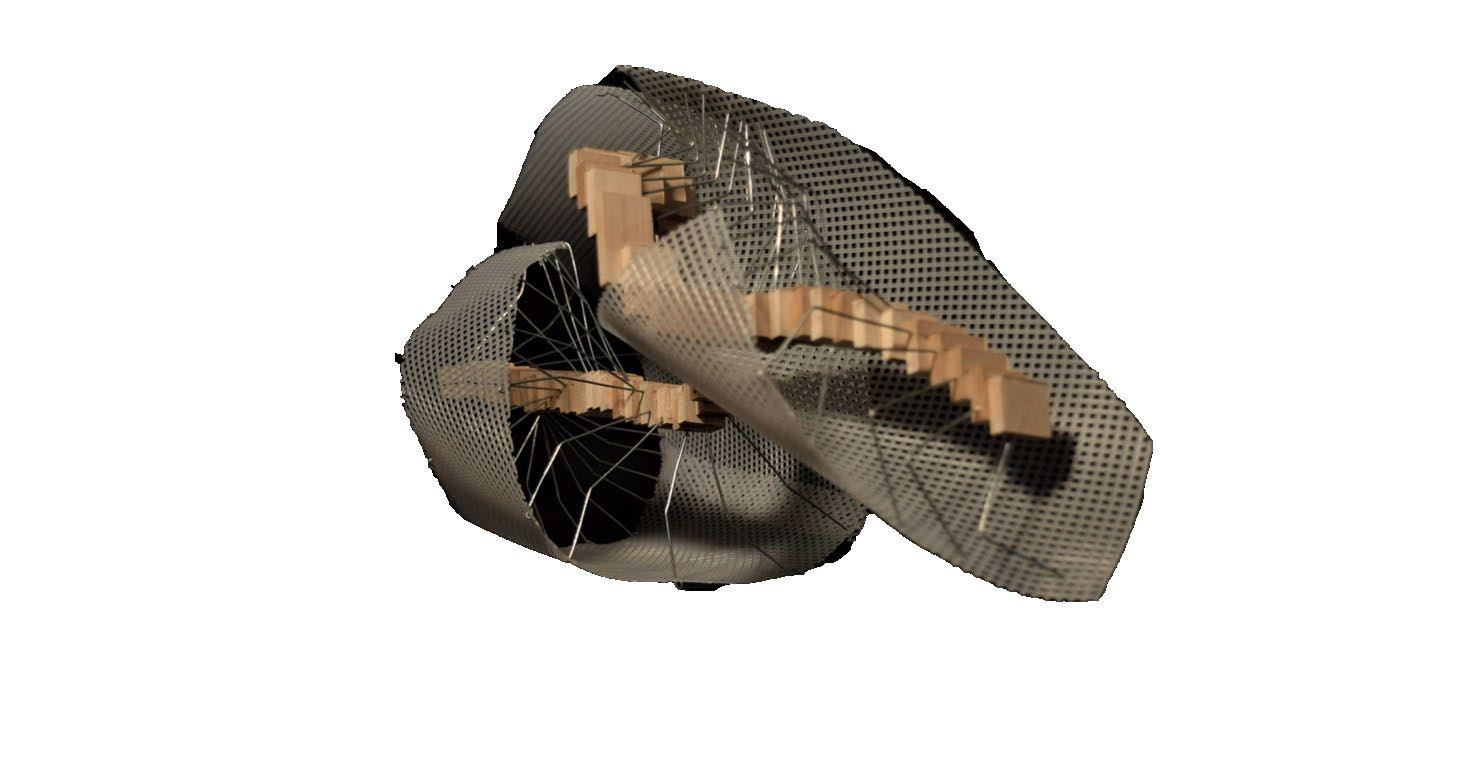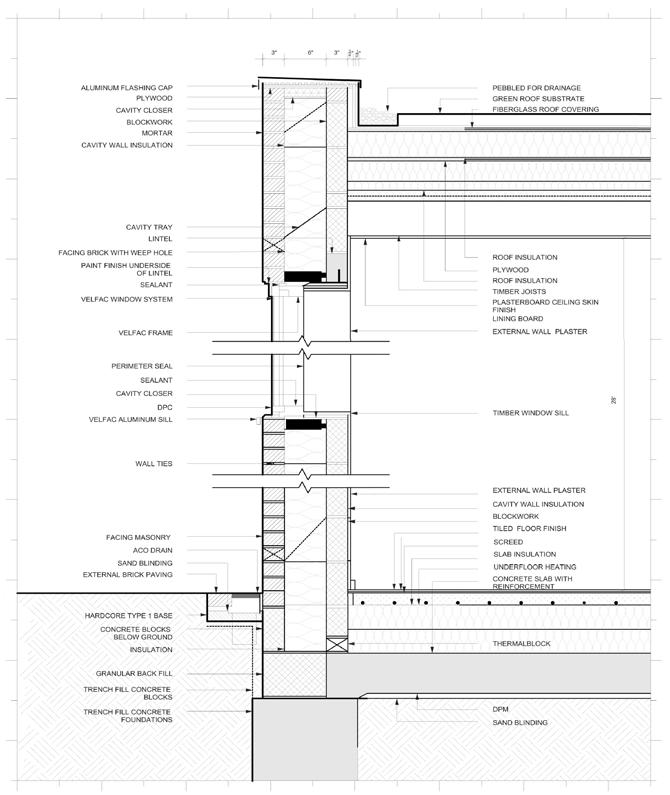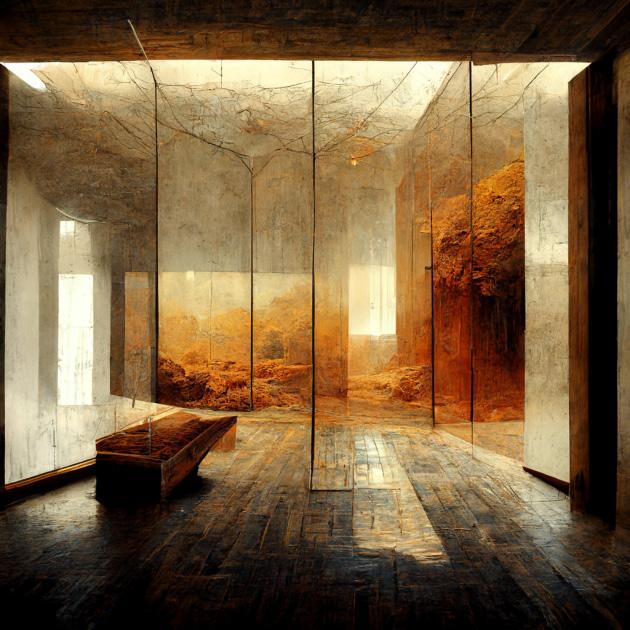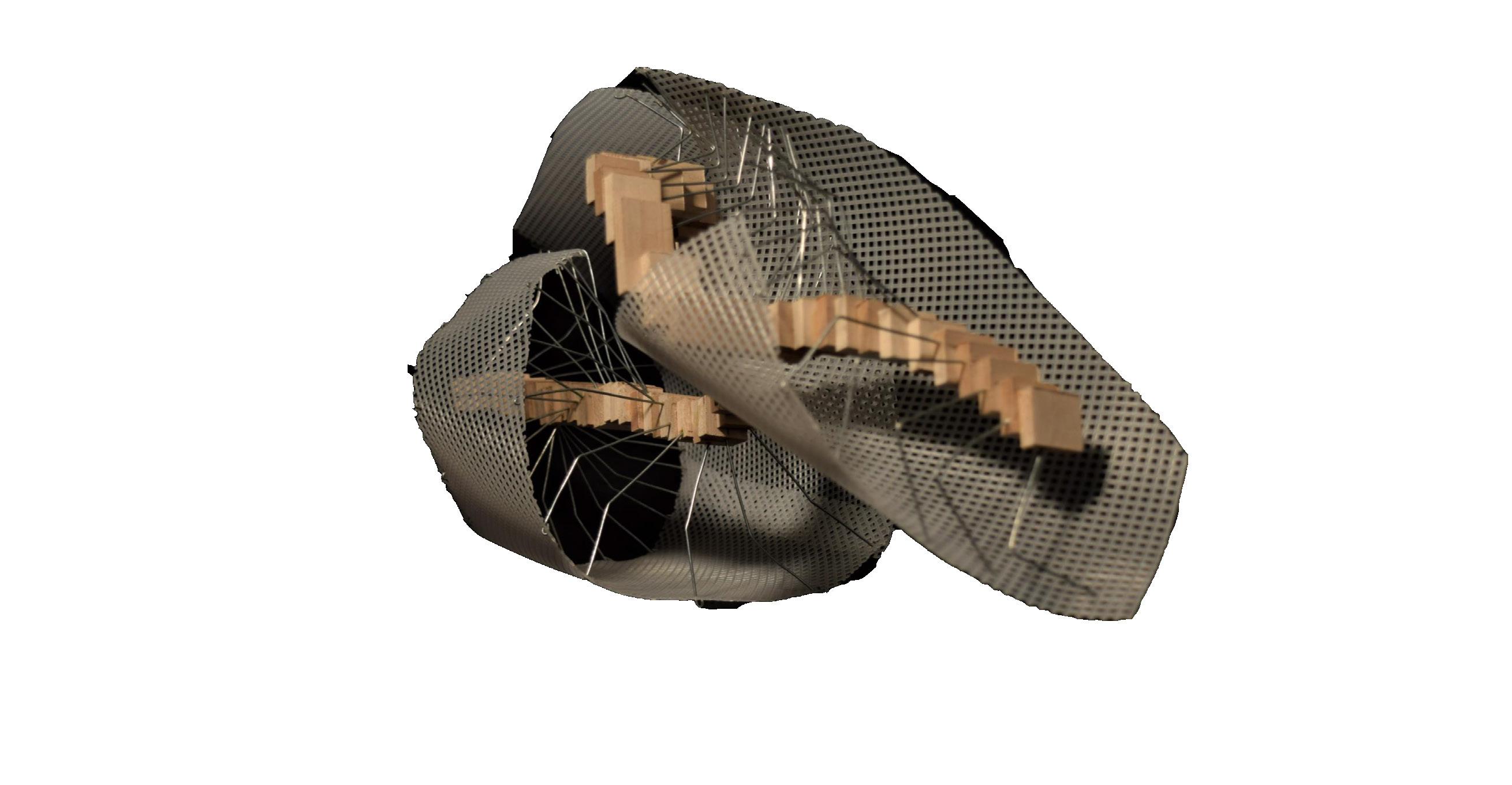

S hylo h ilbert , A ssoc . AIA
Architectural Graduate Student
CONTACT INFORMATION:
School Email: shylo.hilbert@jacks.sdstate.edu
Personal Email: shylohilbert@gmail.com
Phone: 507-217-1364
Linkedin: linkedin.com/in/shylo-hilbert-769231191/
EDUCATION:
South Dakota State University (SDSU)
Master of Architecture
Anticipated Graduation: Aug 2023
GPA: 4.0
B.F.A in Architecture
Graduation: May 2022
GPA: 3.8
Minnesota Valley Lutheran High School High School Diploma
GPA: 3.6
ACHIEVEMENTS/LEADERSHIP ROLES:
American Institute of Architecture Students (AIAS)
AIAS SDSU President 2021 - 2022
AIAS SDSU Member 2019 - present
AIAS National Member 2020 - present
AIAS SDSU Treasurer 2020 - 2021
Architecture Program Student Advisory Board (SAB)
SAB Coordinator 2022 - present
5th Year Representative 2022 - present
4th Year Representative 2021 - 2022
SDSU Undergraduate Deans list
Fall: 2018, 2019, 2020, 2021
Spring: 2020, 2021, 2022
Tau Sigma Delta Honor Society in Architecture and Allied Arts
Lifelong Membership: 2022 Inductee
SDSU DoArch Super-Review Award Recipient (Cancelled Spring 2020 Discontinued after Spring 2021) Fall 2019, Fall 2020, Spring 2021
City Ambassador of Gibbon, Minnesota Ambassador/Aquatennial Participant 2018-2019
VOLUNTEER OPPORTUNITIES:
ABC School Guest Speaker/Facilitator - 2022
Discussion on the power dynamics of studio pedagogy and curriculum design led by Federico Garcia Lammers.
Architecture Lobby Discussion Panelist - 2022
Discussion between panelists from SDSU, SciArc and Bartlett on unjust and unaccountable leadership within each respective institution.
SDSU Department of Architecture (DoArch)
Representative and SDSU Student Panelist - 2021 Spoke to potential students on balancing school and extracurricular activities as an Architecture student, answering questions as needed.
Habitat for Humanity - 2021
Collaborating with others to put siding on a newly built home in Brookings, SD.
EXPERIENCE:
KOCH HAZARD ARCHITECTS INTERN
Sioux Falls, SD May 2022 - Jan 2023
Drafted detailed drawings, specifying dimensions and assigning materials needed for projects.
Assisted in multiple projects in Schematic Design, Design Development, and Construction Documents phases.
Assisted in on site verifications through conducting construction punch lists and 1 year-Warranty walk-throughs.
SOUTH DAKOTA STATE UNIVERSITY UNDERGRADUATE RESEARCH ASSISTANT
Brookings, SD Jan 2022 - May 2022
This research focused on design proposals for revitalizing the downtown historical district of Arkansas City, Kansas in partner with the Kansas State University Technical Assistance to Brownfields (TAB) organization.
A cross-disciplinary collaboration amongst fellow Architecture, Landscape Architecture, Interior Design and Graphic Design students.
VOLT / 3M - EHS SUMMER INTERN
New Ulm, MN May 2021 - Aug 2021
Evaluated physical and digital records to determine potential risk and analyze compliance with guidelines.
Conducted safety audit operations to assess performance and verify efficiency of established control systems.
SOUTH DAKOTA STATE UNIVERSITY TEACHING ASSISTANT
Brookings, SD Aug 2019 - Dec 2019
Maintained open communication to serve as educational and information resource to students during and outside of classroom lectures.
Evaluated student feedback and responses towards the class structure, relaying the information with the professor and strategizingx ways of improvement.
SKILLS:
• Rhino
• Revit
• SketchUp
• Grasshopper
• Lumion
• Twinmotion
REFERENCES:
• Enscape
• Indesign
• Illustrator
• Photoshop
• Lightroom
• Microsoft Tools
Dr. Nesrine Mansour - SDSU School of Design Assistant Professor Nesrine.Mansour@sdstate.edu
Jessica Garcia Fritz - Assistant Professor at School of Architecture, University of Minnesota frit0134@umn.edu
Stacey McMahan - Principle and Director of Design Operations at Koch Hazard Architects smcmahan@kochhazard.com

ARCH 452 - B uilding S tudio ii


PIVOT: BUILDING ON THE PAST
4th Year - 2022 Spring Semester
INSTRUCTORS:
Dr.
Nesrine Mansour, Federico Garcia Lammers, Jessica Garcia Fritz, Sean ErvinPROGRAM/SOFTWARE/MEDIA:
Revit 2021
Rhino 6
Photoshop
Illustrator

Laser Cutter

Hot Wire Cutter
Concrete Casting
COURSE DESCRIPTION:
The vertical building design studio is a collective of students ranging from second to fifth year. The class centers around the study and production of detailed material and structural characteristics of architectural elements, including foundations, walls, floors, roofs, openings, and various construction systems. The studio aims to demonstrate the interconnectivity of conceptual and technical design criteria in building design.
The class then undertook the design of an addition to the Agricultural Heritage Museum on the SDSU campus, with the vision of preserving South Dakota’s agricultural history and connecting multi-generational audiences to the significance of agriculture in their everyday lives. However, preservation should not only be directed towards the past but also towards the future. The addition is intended to showcase the importance of sustainable practices in South Dakota agriculture, with the aim to PIVOT visitors’ minds towards a sustainable future.
PIVOT features a 12-foot high steel truss bridge that symbolically connects the Brookings community to the new Precision Ag building on campus. The 170-foot bridge, enclosed by translucent glass panels and wooden slates, rests upon two timber structured masses that are constructed from the central PIVOT point on the bridge. One mass cuts through the existing basement of the Ag Museum, leaving an imprint in steel columns of what once was and creating a glimpse of what will be. The PIVOT point features a fountain and a stepping site that directs visitors to the northwest corner where an active learning environment of a sustainable farm awaits. Here, visitors can explore the preservation of the future of agriculture in South Dakota in greater depth.
COLLABORATORS:
Autumn Schlomer (5th Year), Jack Walsh (2nd Year), Zack Messner (2nd Year
IMAGES:
A.1-A.5 - Building Diagrams: Parti, Symmetry, Massing, Program, and Circulation

A.6 - Site Plan and Bridge Sections





IMAGES:
A.9 - Bridge Section Detail - Done in collaboration with Jack Walsh
A.10 - Auditorium Section Detail - Done in collaboration with Autumn Schlomer




A.11
IMAGES:
A.11 - Detailed Section Model Progression Images
A.12 - Exterior Bridge Rendering - Done in Collaboration with Zack Messner






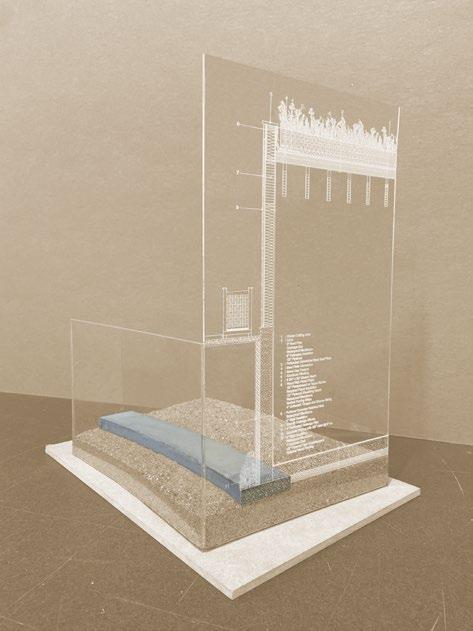

A.13 - Interior Bridge Rendering - Done in Collaboration with Zack Messner






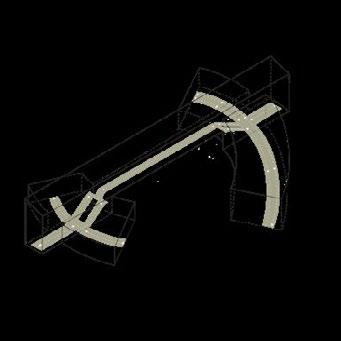



ARCH 355 - B uilding S tudio i
TECHNICAL AFTERTHOUGHTS
3rd Year - 2021 Spring Semester
INSTRUCTORS:
Robert Arlt, Dr.
Nesrine Mansour, Brian Lee, Jessica Garcia Fritz, Federico Garcia LammersPROGRAM/SOFTWARE/MEDIA:
Rhino 6
Revit 2020
Photoshop IllustratorCOURSE AND PROJECT DESCRIPTION:
The Building Studio incorporates a comprehensive approach towards integrating the specificity of technical vignettes in connection with architectural conceptualization. By analyzing, comprehending, and drafting foundation, wall, and roofing details, the understanding of construction systems and structural elements becomes better understood for further and future application.
These technical afterthoughts are then curated into a uniform composition, which abides by and is applied to the project’s parameters. The primary objective of phase one of the project was to design a site-specific gym, requiring graphic clarity through orthographic means to portray a set selection of material choices and supports throughout the entire building’s envelope (Foundation, Wall, and Roof Assemblies).
The building design incorporated an entry space on the northwest, centralized restrooms, a sawtooth roofing system, and a sunken gym to meet on grade with the northeast corner of the site which has a sub 4’ difference from the southwest corner of the site.
Following the completion of the gym, the space was adapted to conform to the needs of a library. Through redlining and an assortment of line types, additions and changes are made clear in contrast to the already existing structure of the gym. A second-floor mezzanine, front desk, and tiered learning spaces were the primary additions made to the original layout of the gym.
This project was centered primarily around making critical decisions on design positions while maintaining graphic clarity through numerous iterations.
SDSU DoArch Super-Review Participant and Award Recipient
IMAGES:
B.1 - Technical Vignette of Building Envelope



B.2 - Technical Vignette of Foundation and Wall
B.3 - Technical Vignette of Foundation
B.4 - Technical Vignette of Wall and Roof

B.5
B.6
IMAGES:
B.5 - Elevation Image of Gym/Library - South Side


B.6 - Longitudinal Section Image of Gym/Library
B.7 - Mezzanine / Upper Level Floor Plan
B.8 - Ground Level Floor Plan


B.9
IMAGES:
B.9 - Section Highlighting Areas Shown
B.10 - Detailed Transverse Section Image (Second Floor - South Side)



B.11 - Detailed Transverse Section Image (Second Floor - North Side)
B.10

IMAGES:
B.12 - Section Highlighting Areas Shown
B.13 - Detailed Transverse Section Image (Ground FloorSouth Side)

B.14 - Detailed Transverse Section Image (Ground FloorNorth Side)

B.13


ARCH 251 - B uilding A rts s tudio i
SPATIAL TRANSLATIONS
2nd Year - 2019 Fall Semester
INSTRUCTOR:
B rian Lee
PROGRAM/SOFTWARE/MEDIA:
H and Drafting
Basswood
Painted Blue Foam
Hot Wire Cutter
Bandsaw
COURSE AND PROJECT DESCRIPTION:
The premise of this project is to translate a physical human motion into an ambiguous interpretation to formulate an architectural spatial rendition. This process began with a comprehensive writing on the actions of the motion without explicitly stating what the motion is. Through images of the motion being performed, drawings were made to express the action with the presence of time, without drawing any identifiable or realistic bodily element (such as an arm or leg). Separating the motion from the body itself resulted in the creation of an abstract array of spiraling line segments, which were then projected three-dimensionally through the spatial embodiment model.
The spatial embodiment model was composed of three material components - basswood, metal wire, and perforated plastic mesh - to form a solid, frame, and shell/skin. The interdependence of each material was crucial to maintain the structural integrity of the model.


The cube model was designed to incorporate certain elements of the previous work and spatial embodiment model while conforming to specific dimensional and material limitations through the use of foam. These limitations consisted of the cube being no more than 6” by 6” and the spaces within must allow a person’s entry when to scale.
Hand drawings of the sections, plans, and elevations of both the spatial embodiment model and cube model were created to provide a more in depth understanding of the spatial and form qualities within both models.
This project demonstrates the ability to utilize abstract interpretations of physical motion to inform architectural spatial renditions. The use of hand drawings and careful material selection demonstrates attention to detail and a comprehensive understanding of the interdependence of various elements in the design process.

IMAGES:
C.1 - Back Left Angle of Spatial Embodiment Model
C.2 - Front Left Angle of Spatial Embodiment Model
C.3 - Right Profile of Spatial Embodiment Model
C.4 - Front Right Angle of Spatial Embodiment Model

IMAGES:
C.5 - OPEN CUBE MODEL

C.6 - CLOSED CUBE MODEL



IMAGES:
C.7 - VARIOUS CUBE ELEVATIONS, TOP AND INTERIOR HALF


C.8 - HAND DRAWN SECTION OF PHYSICAL CUBE MODEL




C.9 - HAND DRAWN PLAN OF PHYSICAL CUBE MODEL
C.10 - ELEVATION DRAWING OF SPATIAL EMBODIMENT MODEL

C.11 - SECTION DRAWING OF SPATIAL EMBODIMENT MODEL





ARCH 252 - B uilding A rts s tudio ii
GENERATION OF SECTION
2 nd Year - 2020 Spring Semester
INSTRUCTORS:
Jessica Garcia FritzPROGRAM/SOFTWARE/MEDIA:
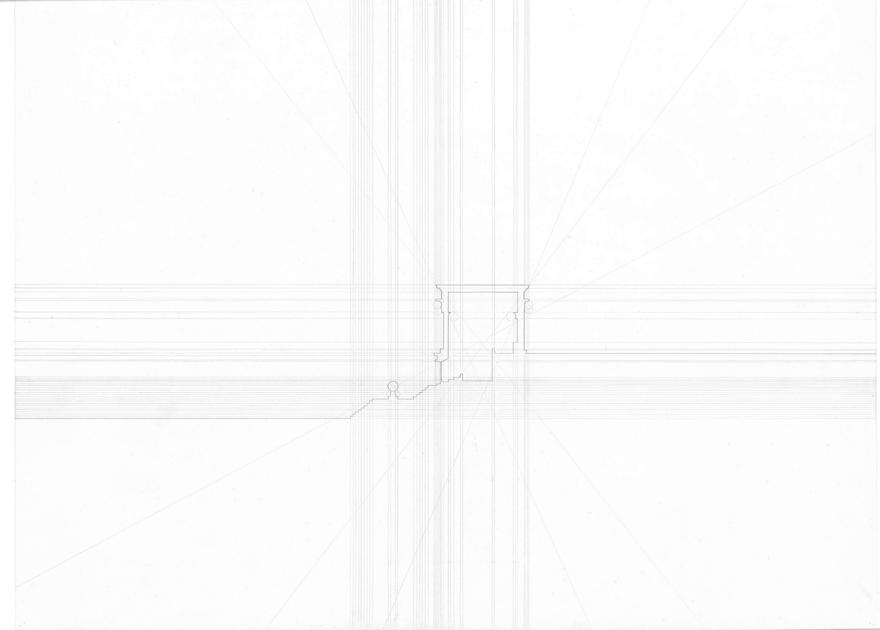

Hand Drafting
Museum Board
Wooden Dowels
Laser Cutter
Rhino 6
COURSE PROJECT DESCRIPTION:
The objective of this project is to demonstrate the ability to effectively communicate design intentions through a variety of analytical and creative processes, including reading, writing, hand drafting, photography, and physical and digital model making. The aim is to create superimposed compositions that elaborate and expand upon the spatial relationships present in a building or complex, highlighting the unique outcomes and conditions produced by each method.
To achieve this, students were assigned differing combinations of case study images of buildings from different time periods, including the Renaissance, Enlightenment, Modernist, and Contemporary eras. These buildings were used to understand the variance of the spatial, structural, and elemental composition between the buildings and time periods from which they were constructed. The drafting of these sections, created through scaling and measuring the original images, emphasized the importance that one must first be able to read the building before one is able to recreate it.
The hand drafted images were then digitized and transformed through mirroring, scaling, rotating, and other techniques to create a superimposed juxtaposition. Through multiple iterations and form explorations, the sections were laser cut and mounted on wooden dowels, allowing for adjustable spacing options and numerous possibilities for spatial perception.
The use of a digitally drawn 3D model allowed for a series of varying possibilities and outcomes in spatial identification, helping to narrow down informed decisions on the spatial components and ordering of the model. This process revealed how individual spaces compare in relation to each other and to the model as a whole, leading to a more comprehensive understanding of the building’s spatial components and relationships.
IMAGES:
D.1 - Hand Drawing of Park Tower

D.2 - Hand Drawing of Salk Institute
D.3 - Hand Drawing of Santa Maria Della Carceri
D.4 - Hand Drawing of Laperouse Mausoleum
D.5 - Hand Drawing of Sao Paulo Art Museum
D.1 D.2 D.3 D.4


IMAGES:
D.6 - Physical Section Model
D.7 - Longitudinal and Transverse Rhino Section Image
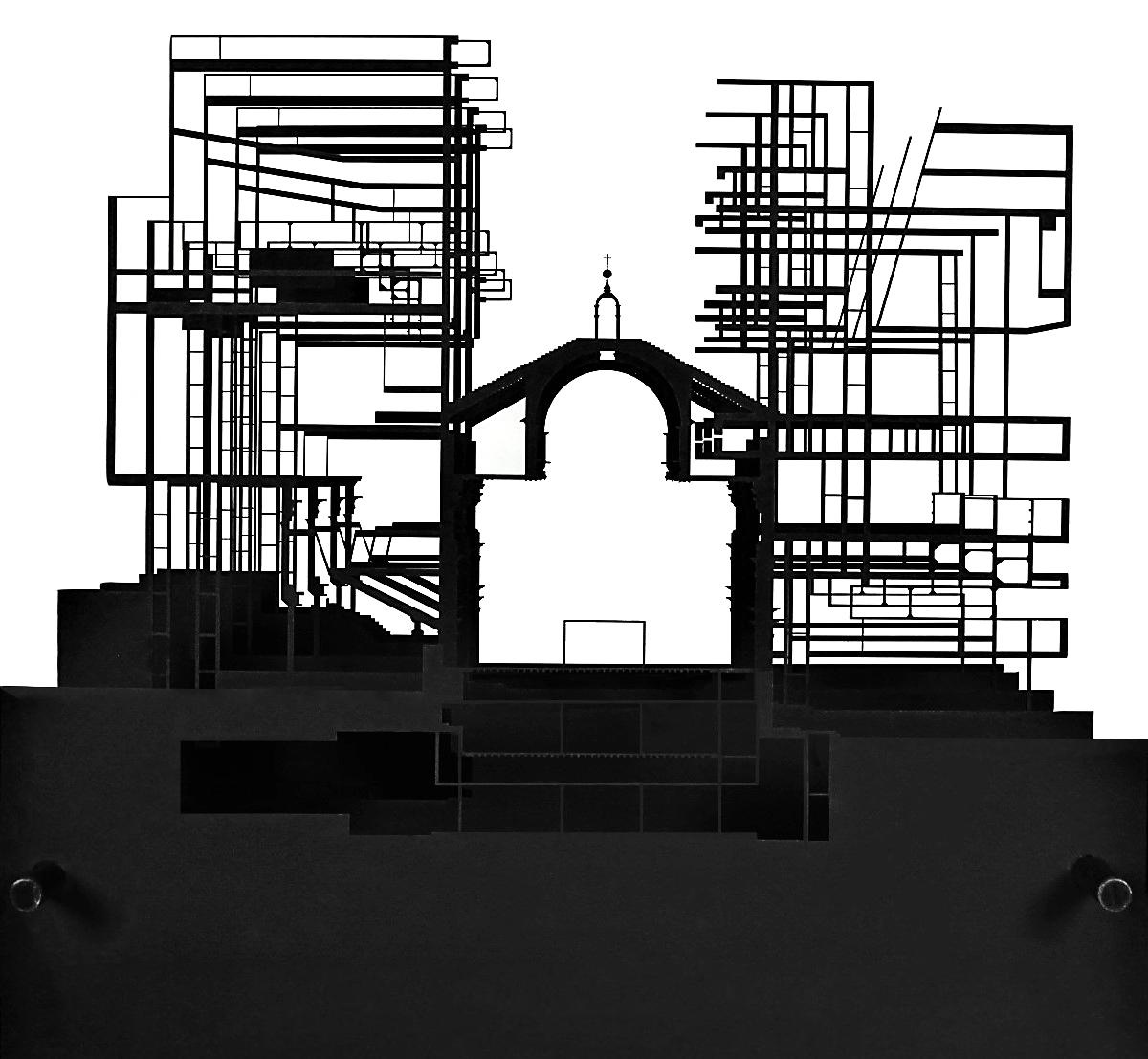

IMAGES:
D.8 - Composite Rhino Model Spatial Study Images





D.9 - Selected Spatial Components of Composite Model


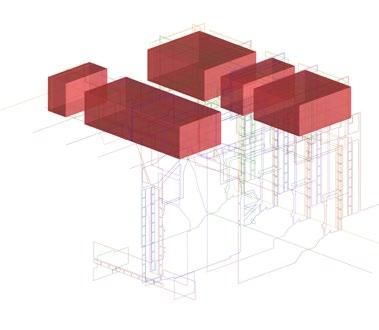






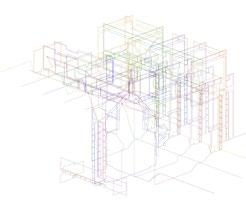
D.10 - Complete Composite Model

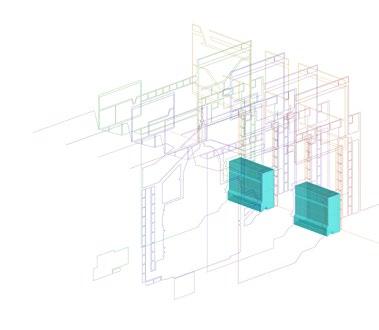










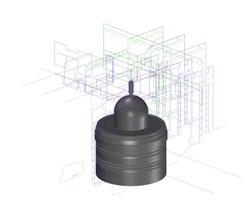


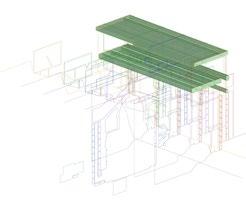




ARCH 654 - R esea R ch s tudio
THE SCARED IN BETWEEN
5th Year - 2022 Fall Semester
INSTRUCTORS:
Dr. Nesrine MansourPROGRAM/SOFTWARE/MEDIA:
Midjourney AI
Rhino 7
Revit
Lumion
Photoshop
Illustrator
Grasshopper
COURSE AND PROJECT DESCRIPTION:
This research studio provides students the opportunity to explore the concept of “the sacred” by creating digital and physical artifacts that investigate the intricate light-based complexities of sacred spaces, and the connections to various spiritual practices.


The Sacred in Between studio’s theoretical and practical approach centers around Light, which is used as the primary means to examine the complex connections between space, place, and architecture, as well as human experience through research, modeling and imagery. Defining what constitutes a sacred space is a complex task, requiring an in-depth understanding of factors such as location, function, aesthetics, faith, and beliefs, which all contribute to the creation of sacredness. The focus on Light is an effective way to examine these socio-spatial complexities.
To create a spatial quality that embodies a display of coruscation and brilliance both on the interior and exterior, the exploration of Artificial Intelligence, particularly Mid-Journey AI, was utilized to generate digital sketches alongside hand sketches. Mid-Journey AI enabled us to investigate two primary dichotomies, namely the sacred and the profane, to create the sketched renders. Sacred being an experience that induces the feeling of awe and profane being that of the everyday mundane. Throughout the semester, we analyzed numerous case studies to understand the spatial qualities of these dichotomies.
We analyzed both natural and artificial lighting elements through Geometry, Source, Direction, and Quality. The aim is to create an experience in which both residents and visitors see our project as a destination within Downtown Brookings that provides a calming reflective opportunity for meditation.
The design problem we addressed was the lack of a space open all day for meditation and relaxation in Brookings.
COLLABORATOR: Anna Hamling (4th Year)
IMAGES:
E.1-E.4 - Midjourney Explorative Sketches and Idea Generating of Interior Lighting Qualities


IMAGES:
E.5 - Building Parti in Plan and Axonometric
E.6 - East Elevation
E.7 - Site Plan

E.8 - North Elevation




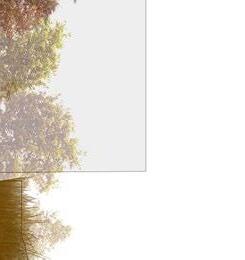



IMAGES:

E.9 - Cross Section
E.10 - Longitudinal Section

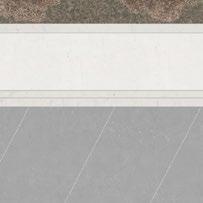
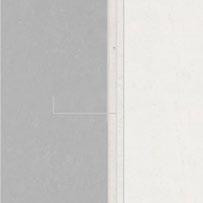








E.11 - Floor and Circulation Plan
E.12 - Renderings of Digital Model and Images of Physical Models


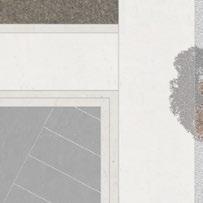




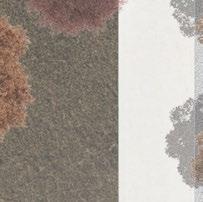







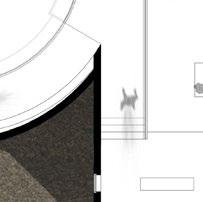


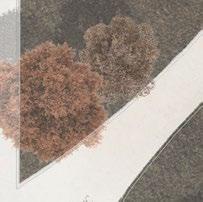






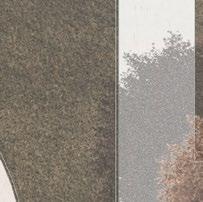


















E.13
IMAGES:

E.13 - Lumion Rendered Views and Lightbox Model Study Images




E.14 - Physical Site Model

